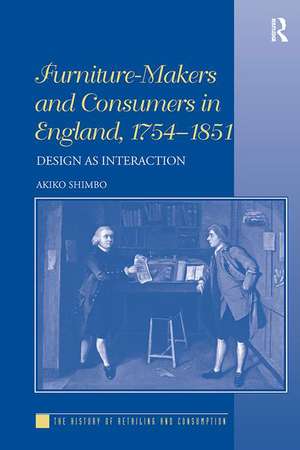Furniture-Makers and Consumers in England, 1754–1851: Design as Interaction: The History of Retailing and Consumption
Autor Akiko Shimboen Limba Engleză Paperback – 2 aug 2017
| Toate formatele și edițiile | Preț | Express |
|---|---|---|
| Paperback (1) | 299.52 lei 6-8 săpt. | |
| Taylor & Francis – 2 aug 2017 | 299.52 lei 6-8 săpt. | |
| Hardback (1) | 1007.36 lei 6-8 săpt. | |
| Taylor & Francis – 28 noi 2015 | 1007.36 lei 6-8 săpt. |
Preț: 299.52 lei
Preț vechi: 356.64 lei
-16% Nou
Puncte Express: 449
Preț estimativ în valută:
57.32€ • 62.24$ • 48.15£
57.32€ • 62.24$ • 48.15£
Carte tipărită la comandă
Livrare economică 22 aprilie-06 mai
Preluare comenzi: 021 569.72.76
Specificații
ISBN-13: 9781138307155
ISBN-10: 1138307157
Pagini: 280
Dimensiuni: 156 x 234 mm
Greutate: 0.45 kg
Ediția:1
Editura: Taylor & Francis
Colecția Routledge
Seria The History of Retailing and Consumption
Locul publicării:Oxford, United Kingdom
ISBN-10: 1138307157
Pagini: 280
Dimensiuni: 156 x 234 mm
Greutate: 0.45 kg
Ediția:1
Editura: Taylor & Francis
Colecția Routledge
Seria The History of Retailing and Consumption
Locul publicării:Oxford, United Kingdom
Cuprins
Contents: Introduction; Furniture design: sharing knowledge among craftspeople; Pattern books: communicating between producers and consumers; Forming taste and style: consumers' needs and participation; The showroom as mediator; Furniture repairs and services: building a clientele; Taste, state and the market: changing relationships between producers and consumers; Conclusion; Appendix; Bibliography; Index.
Notă biografică
Akiko Shimbo is Professor in the Department of Architecture and Environment Systems, School of Systems Engineering and Science, Shibaura Institute of Technology, Japan.
Descriere
Covering the period from the publication of Thomas Chippendale's The Gentleman and Cabinet-Makers' Director (1754) to the Great Exhibition (1851), this book analyses the relationships between producer retailers and consumers of furniture and interior design, and explores what effect dialogues surrounding these transactions had on the standardisation of furniture production during this period. This study examines the role of pattern books and their readers; the construction of taste and style through negotiation; and daily interactions through showrooms and other services, to reveal the complexities of English material culture in a period of industrialisation.















